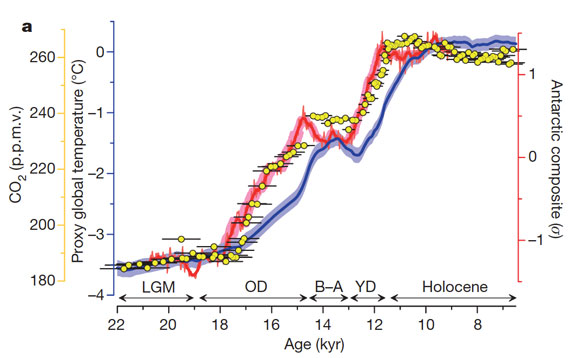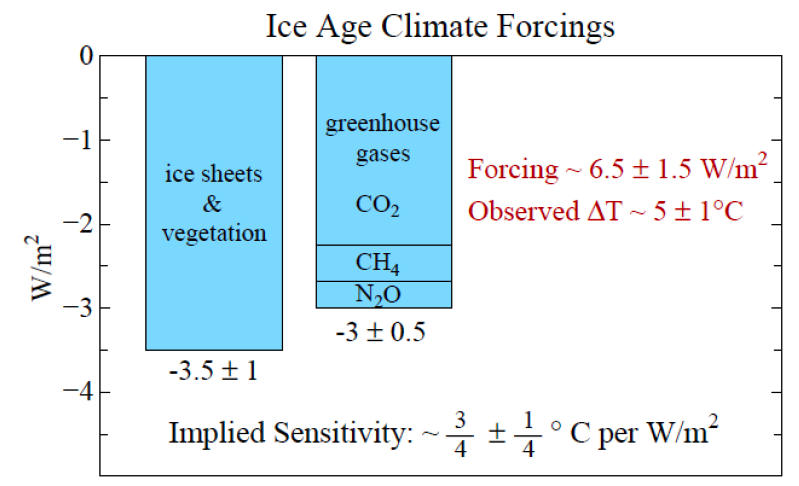
A popular myth amongst climate 'skeptics' is that historically atmospheric CO2 levels have risen after temperature increases began, and therefore it's actually temperature increases that cause CO2 increases, and not vice-versa as basic climate science and physics would have us believe. To this point, the standard response to this myth has been that initial temperature increases have historically been caused by the Earth's orbital (Milankovitch) cycles, which in turn warm the oceans, causing them to release CO2, which in turn amplify the global warming. Thus while the initial warming hasn't historically been caused by CO2, CO2 has amplified the warming for thousands of subsequent years, and thus is still the principal control knob governing Earth's temperature.
An intriguing new paper by Shakun et al. (2012) takes a more in-depth look at this particular myth. Many headlines have declared that Shakun et al. have demonstrated that CO2 has historically led (rather than lagged) global warming - the reality is a little more nuanced than that, but that is the basic take-home message. In Figure 1, the red line (Antarctic temperature) and yellow dots (atmospheric CO2) illustrate our previous unerstanding, while the blue line (global temperature) is the nuance added by Shakun et al.
Figure 1: The global proxy temperature stack (blue) as deviations from the early Holocene (11.5–6.5 kyr ago) mean, an Antarctic ice-core composite temperature record (red), and atmospheric CO2 concentration (yellow dots). The Holocene, Younger Dryas (YD), Bølling–Allerød (B–A), Oldest Dryas (OD) and Last Glacial Maximum (LGM) intervals are indicated. Error bars, 1-sigma; p.p.m.v. = parts per million by volume. Shakun et al. Figure 2a.
The key to this myth is that it's based on Antarctic ice core records, which are not necessarily an accurate representation of global temperatures. In recent years there have been many studies collecting data from ice cores in Greenland, sediments drilled from the ocean floor and from continental lakes, and so forth. Most of these proxies don't extend as far back in time as the Antarctic ice cores, but many do extend back to the last glacial-interglacial transition which began approximately 18,000 years ago, as Figure 1 shows.
Shakun et al. examined 80 such proxy records from around the globe (Figure 2), recording sea surface temperatures for the marine records and surface air temperatures.
Figure 2: Proxy temperature records. a) Location map. CBT = cyclization ratio of branched tetraethers; MBT = methylation index of branched tetraethers; TEX86 = tetraether index of tetraethers consisting of 86 carbon atoms; Uk37 = 37, alkenone unsaturation index. b) Distribution of the records by latitude (grey histogram) and areal fraction of the planet in 5° steps (blue line). Shakun et al. Figure 1.
By comparing the atmospheric CO2 increase (note that since CO2 is well-mixed in the atmosphere, a single ice core record can be used as an accurate representation for CO2 - Shakun et al. used the Antarctic EPICA Dome C ice core for CO2 data) to these many different temperature records, Shakun et al. are able to discern whether the CO2 increase led or lagged temperature changes in various different geographic locations, and for the planet as a whole.
This is where it really gets interesting, because the answer is yes - CO2 lags and leads. In the Southern Hemisphere, Shakun et al. found that the temperature rise happened first, whereas in the Northern Hemisphere, the CO2 increase was first (Figures 3 and 4).
Figure 3: The phasing of CO2 concentration and temperature for the global (grey), Northern Hemisphere (NH; blue) and Southern Hemisphere (SH; red) proxy stacks based on lag correlations from 20–10 kyr ago in 1,000 Monte Carlo simulations. The mean and 1-sigma of the histograms are given. CO2 concentration leads the global temperature stack in 90% of the simulations and lags it in 6%. Shakun et al. Figure 2b.
Figure 4: Proxy temperature stacks for 30° latitude bands with 1-sigma uncertainties. The stacks have been normalized by the glacial–interglacial (G–IG) range in each time series to facilitate comparison. Shakun et al. Figure 5b.
What appears to have happened, based on global climate model simulations run by Shakun et al., is not all that different from our previous explanation of the supposed CO2 lag - just a bit more nuanced.
In short, the initial warming was indeed triggered by the Milankovitch cycles, and that small amount of orbital cycle-caused warming eventually triggered the CO2 release, which caused most of the glacial-interglacial warming. So while CO2 did lag behind a small initial temperature change (which mostly occurred in the Southern Hemisphere), it led and was the primary driver behind most of the glacial-interglacial warming.
According to the Shakun et al. data, approximately 7% of the overall glacial-interglacial global temperature increase occurred before the CO2 rise, whereas 93% of the global warming followed the CO2 increase.
Shakun et al. did not address the question of climate sensitivity in their paper. Readers may recall a paper by Schmittner et al. which used the glacial-interglacial transition to estimate climate sensitivity, and came up with an estimate (1.7–2.6°C with a best estimate of 2.3°C global surface warming in response to doubled CO2) towards the lower end of the IPCC range (2.0–4.5°C with a best estimate of 3°C). However, this lower estimate could mostly be attributed to Schmittner et al.'s low estimate of the glacial-interglacial temperature change, of just 2.6°C globally (most previous estimates put the value at around 5°C).
Shakun et al. estimate the global surface temperature change at approximately 4°C during the transition. A similar paper by many of the same authors recently published in the Proceedings of the National Academy of Science (Clark et al. 2012) estimates the greenhouse gas radiative forcing during the transition at approximately 2.5 Watts per square meter (W/m2), but neither Shakun nor Clark et al. estimated the total radiative forcing (including surface reflectivity changes, for example). Overall, the estimated temperature changes and radiative forcings are both slightly lower than in Hansen and Sato (2011) (Figure 5).

Figure 5: Climate forcings during the ice age 20,000 years ago relative to the pre-industrial Holocene from Hansen and Sato (2011)
Similar to the implied sensitivity in Hansen and Sato, a ~4°C global temperature change caused by a ~6 W/m2 forcing corresponds to a ~2.5°C sensitivity to doubled CO2. Note that this is a very rough estimate based on the Shakun and Clark results, but is within the IPCC climate sensitivity range.
Not surprisingly, since the 'CO2 lags temperature' myth is a climate denialist favorite (coming in at #12 on the most-used climate myths list), the reaction has predictably been one of, well, denial. WattsUpWithThat in particular has devoted several posts denying the results in the Shakun et al. paper. One such post quoting Don Easterbrook (of failed global cooling prediction fame) began with the following objection:
"1. They assume that CO2 is capable of causing climate changes..."
Need we continue? We could devote an entire post to the glaring errors from Easterbrook in this WUWT post, but let's not.
In the same post, Willis Eschenbach criticized the paper saying "My rule of thumb about these kinds of things is, no error bars … no science." However, Shakun et al. were quite explicit about the associated uncertainties throughout the paper (for example, see the uncertainty ranges depicted in Figures 1 and 4 above). Upon actually reading the paper, Eschenbach's criticism rings quite hollow.
Speaking of apparently not reading the paper before attacking it, a second WUWT post on Shakun et al. (also from Eschenbach) argued that their results are not valid because the glacial-interglacial warming occurred at different times in the different temperature proxies. But that is of course the point - the Southern Hemisphere warmed before the CO2 increase, while the Northern Hemisphere warmed after (as Figures 3 and 4 show). In looking for an excuse to reject this research, the denialists manage to miss the entire point of the paper.
In yet a third post, this one by Watts himself, Watts objects that Shakun et al. refuse to call orbital cycles the warming "trigger." This is a little bit silly, since the authors titled an entire section of their paper The trigger for deglacial warming, discussing that the first warming (of the Arctic 19,000 years ago) was indeed triggered by orbital cycles.
The knee-jerk denial rejections of the Shakun et al. results reflect the inconvenience of their results for the climate "skeptics." The authors summarize their intriguing results, which expand upon our understanding of glacial-interglacial transitions.
"Lag correlations from 20–10 kyr ago suggest that the modelled global temperature lags CO2 concentration by 120 yr, which is within the uncertainty range of the proxy-based lag."
{...}
"Our global temperature stack and transient modelling point to CO2 as a key mechanism of global warming during the last deglaciation. Furthermore, our results support an interhemispheric seesawing of heat related to AMOC variability and suggest that these internal heat redistributions explain the lead of Antarctic temperature over CO2 while global temperature was in phase with or slightly lagged CO2."
Also see good coverage of this study by Climate Crocks, The Washington Post, and BBC.
Note: the Shakun et al. results have been incorporated into the CO2 lags temperature myth rebuttals.
Posted by dana1981 on Tuesday, 10 April, 2012
 |
The Skeptical Science website by Skeptical Science is licensed under a Creative Commons Attribution 3.0 Unported License. |